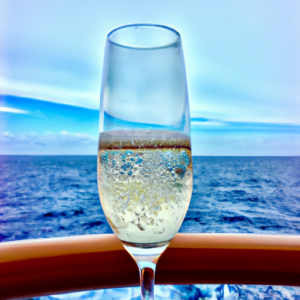Embark on an unforgettable adventure as you set sail on an eco-friendly cruise that goes beyond breathtaking landscapes and luxury amenities. In this article, you will discover essential tips on how to become a responsible cruiser, from minimizing plastic use to actively supporting local conservation initiatives. Join the movement towards a more sustainable future and make a positive impact while indulging in the wonders of the sea.
Table of Contents
ToggleOptimizing Plastic Use by Preventing Waste
Using reusable water bottles
One of the simplest and most effective ways to prevent plastic waste on a cruise is by using reusable water bottles. Rather than relying on single-use plastic water bottles, bring your own refillable bottle. Many cruise ships have water stations where you can easily refill your bottle throughout the day. By doing so, you eliminate the need for plastic bottles, reducing the amount of waste generated on board.
Avoiding single-use plastics
In addition to using reusable water bottles, it is important to actively avoid single-use plastics while on a cruise. This means saying no to plastic straws, disposable cutlery, and plastic bags. Bringing your own reusable utensils and cloth bags can make a significant impact in reducing plastic waste. Additionally, when purchasing souvenirs, opt for items that are not wrapped in plastic packaging. By being mindful of your plastic consumption, you can contribute to a more sustainable cruise experience.
Implementing a plastic recycling program
Cruise ships can also take proactive measures to prevent plastic waste by implementing a comprehensive plastic recycling program. This program can involve collecting and segregating plastic waste on board and ensuring that it is properly recycled or disposed of. By providing designated recycling bins and educating passengers about the importance of recycling, cruise ships can significantly reduce the amount of plastic waste that ends up in landfills or polluting our oceans.
Sustainable dining options
Sourcing local and organic ingredients
One of the key components of an eco-friendly cruise experience is sustainable dining. Cruise ships can prioritize sourcing local and organic ingredients to create delicious meals for passengers. By supporting local farmers and sustainable agricultural practices, cruise ships can minimize their carbon footprint and contribute to the local economy. Additionally, organic ingredients are free from harmful pesticides and chemicals, promoting healthier and more environmentally friendly dining options.
Offering plant-based meal choices
Another way to promote sustainability in cruise dining is by offering plant-based meal choices. Plant-based diets have a significantly lower environmental impact compared to diets that rely heavily on animal products. By incorporating more vegetarian and vegan options into their menus, cruise ships can cater to a wider range of dietary preferences while also reducing their overall carbon footprint. Plant-based meals can be just as tasty and satisfying, providing passengers with delicious and sustainable dining experiences.
Minimizing food waste
In addition to sourcing sustainable ingredients and offering plant-based meal choices, cruise ships can also implement measures to minimize food waste. Proper planning and portion control can go a long way in reducing the amount of food that goes uneaten and ends up in the trash. Cruise ships can also educate passengers about the importance of mindful eating and encourage them to take only what they can consume. By minimizing food waste, cruise ships can not only reduce their environmental impact but also save on costs.
Eco-conscious packaging
Using biodegradable packaging materials
Another important aspect of an eco-friendly cruise is conscious packaging. Cruise ships can take steps to use biodegradable packaging materials, such as compostable plates and utensils, to minimize their environmental impact. These materials break down naturally over time, reducing the amount of waste that ends up in landfills or in our oceans. By prioritizing biodegradable packaging, cruise ships can show their commitment to sustainability and inspire passengers to adopt similar practices in their own lives.
Encouraging guests to bring reusable containers
Cruise ships can also actively encourage their guests to bring their own reusable containers for taking food and drinks on excursions or to enjoy on board. By providing information about the benefits of reusable containers and promoting their use, cruise ships can help to reduce the reliance on single-use plastics. For example, passengers can bring their own travel mugs or containers to fill up with coffee or other beverages instead of using disposable cups. This simple change can have a significant impact in reducing plastic waste on board.
Partnering with suppliers committed to sustainable packaging
In addition to using biodegradable packaging materials and encouraging guests to bring reusable containers, cruise ships can also partner with suppliers who are committed to sustainable packaging practices. By working with suppliers who prioritize eco-conscious packaging, cruise ships can ensure that the products they offer on board are aligned with their sustainability goals. This collaboration can create a ripple effect, inspiring other companies to adopt similar practices and driving positive change in the industry as a whole.
Water conservation measures
Installing water-saving devices
Water conservation is a crucial aspect of any eco-friendly cruise. Cruise ships can install water-saving devices, such as low-flow faucets and toilets, to reduce water consumption on board. These devices ensure that water is used efficiently without compromising guest comfort. By implementing these measures, cruise ships can significantly minimize their water usage and contribute to the preservation of this precious resource.
Promoting shorter showers and responsible water usage
Another way to conserve water on a cruise is by promoting responsible water usage among passengers. Cruise ships can encourage guests to take shorter showers and turn off the tap when brushing their teeth or washing their hands. Simple reminders and informative signs can go a long way in raising awareness and encouraging responsible water practices. By working together, both the cruise ship and its guests can make a tangible difference in conserving water.
Treating and reusing wastewater on board
Cruise ships can also implement advanced wastewater treatment systems to treat and reuse wastewater on board. By using state-of-the-art technology, cruise ships can ensure that wastewater is treated to meet strict environmental standards before being reused for non-potable purposes, such as flushing toilets or cleaning. This closed-loop system minimizes the amount of fresh water that needs to be taken from the environment and reduces the impact on local water resources.
Energy efficiency initiatives
Utilizing solar panels and wind turbines to generate electricity
Energy efficiency is a key pillar of an eco-friendly cruise. Cruise ships can utilize renewable energy sources, such as solar panels and wind turbines, to generate electricity on board. These eco-friendly alternatives to traditional fossil fuel-based power can significantly reduce greenhouse gas emissions and reliance on non-renewable energy sources. By harnessing the power of the sun and wind, cruise ships can sail towards a greener future.
Optimizing lighting systems to reduce energy consumption
Another way to improve energy efficiency on a cruise is by optimizing lighting systems. Cruise ships can utilize energy-saving LED lights and motion sensors to minimize energy consumption in public areas and guest cabins. These small changes can add up and make a significant impact in reducing overall energy usage. By prioritizing energy-efficient lighting solutions, cruise ships can create a more sustainable and environmentally friendly cruising experience.
Implementing energy-saving measures in guest cabins and public areas
Cruise ships can also implement energy-saving measures in guest cabins and public areas to further reduce energy consumption. This can include using energy-efficient appliances, ensuring proper insulation, and providing guests with information on energy-saving practices. By making conscious choices and being mindful of energy usage, both the cruise ship and its passengers can contribute to a more sustainable voyage.
Sustainable excursion options
Organizing eco-friendly tours and activities
Sustainable excursion options are an important aspect of an eco-friendly cruise. Cruise ships can organize and promote eco-friendly tours and activities that prioritize environmental conservation and responsible tourism. This can include guided hikes, snorkeling trips, or wildlife excursions that are led by knowledgeable guides who prioritize minimizing disruption to natural habitats and wildlife. By partnering with local conservation organizations and promoting sustainable activities, cruise ships can offer unforgettable experiences while also respecting and preserving the local environment.
Supporting local wildlife conservation projects
Cruise ships can also support local wildlife conservation projects through partnerships or direct involvement. By allocating resources and funding to initiatives that aim to protect and restore natural habitats or conserve endangered species, cruise ships can make a positive impact on the local environment. This support can come in the form of grants, volunteer opportunities, or educational programs that raise awareness and promote active participation in conservation efforts.
Educating passengers about the importance of responsible tourism
An integral part of sustainable excursion options on a cruise is educating passengers about the importance of responsible tourism. Cruise ships can provide informative talks and workshops that highlight the environmental and cultural significance of the destinations they visit. By fostering an understanding of the local ecosystems and cultures, passengers can make more informed choices and actively contribute to the preservation of these unique environments. Education plays a vital role in building a sustainable travel mindset that extends beyond the duration of the cruise.
Waste management and recycling
Implementing a comprehensive recycling program on board
Waste management and recycling are critical aspects of an eco-friendly cruise experience. Cruise ships can implement a comprehensive recycling program on board, ensuring that waste is properly segregated and recycled. By providing clearly labeled recycling bins and educating passengers about the importance of recycling, cruise ships can reduce the amount of waste that ends up in landfills or polluting our oceans. This commitment to recycling promotes a circular economy and contributes to the conservation of resources.
Reducing food waste through proper planning and portion control
Food waste is a significant issue on cruise ships, but it can be mitigated through proper planning and portion control. Cruise ships can work closely with their chefs and culinary teams to develop menus and portion sizes that minimize food waste without compromising the dining experience. Additionally, cruise ships can educate passengers about the importance of mindful eating and encourage them to take only what they can consume. By implementing these measures, cruise ships can significantly reduce food waste and its environmental impact.
Donating usable items to local organizations at ports of call
Cruise ships can also minimize waste by donating usable items to local organizations at ports of call. This can include items such as furniture, linens, or kitchen equipment that are no longer needed on board. By partnering with local charities or organizations, cruise ships can give these items a second life while supporting the needs of the local community. This collaboration not only reduces waste but also fosters positive relationships with the destinations visited.
Supporting local communities
Partnering with local businesses and artisans
An eco-friendly cruise goes beyond environmental sustainability; it also encompasses supporting local communities. Cruise ships can partner with local businesses and artisans to promote and sell locally made products on board. By doing so, cruise ships contribute to the local economy, support small-scale businesses, and provide passengers with authentic and unique souvenirs. This collaboration strengthens the bond between the cruise ship and the communities it visits, creating a positive and mutually beneficial relationship.
Investing in community development projects
Another way to support local communities is by investing in community development projects. Cruise ships can allocate resources and funds to initiatives that aim to improve the infrastructure, education, healthcare, or conservation efforts of the local communities visited. This investment can have a lasting impact, providing tangible benefits and enhancing the well-being of local residents. By prioritizing community development, cruise ships can play a vital role in creating sustainable and resilient communities.
Providing employment and training opportunities to local residents
Cruise ships can also contribute to local communities by providing employment and training opportunities to local residents. This can include hiring local staff members, such as tour guides or hospitality personnel, and offering training programs that enhance their skills and professional development. By creating employment opportunities, cruise ships empower local residents and support economic growth. This direct interaction between passengers and local employees also enriches the cultural exchange and enhances the overall cruise experience.
Educational programs and awareness
Hosting environmental workshops and seminars
Education and awareness play a crucial role in promoting sustainable practices on a cruise. Cruise ships can host environmental workshops and seminars that highlight the importance of environmental conservation and provide actionable tips for passengers to adopt eco-friendly behaviors. These engaging and interactive sessions can cover a wide range of topics, from marine conservation to responsible waste management. By fostering a deeper understanding of the environment, cruise ships can inspire passengers to become ambassadors for sustainability even after their voyage ends.
Raising awareness about plastic pollution and its impact on marine ecosystems
One of the key educational focuses on an eco-friendly cruise is raising awareness about plastic pollution and its impact on marine ecosystems. Cruise ships can organize informational sessions, film screenings, or exhibitions that highlight the devastating effects of plastic waste on marine life. By showcasing the need for collective action and providing practical solutions, cruise ships can empower passengers to make more conscious choices and actively participate in plastic reduction efforts.
Collaborating with environmental organizations to conduct research and data collection
Cruise ships can also collaborate with environmental organizations to conduct research and data collection during their voyages. By providing access to marine and coastal areas, cruise ships can support scientific studies and contribute valuable data to ongoing research efforts. This collaboration can enhance our understanding of marine ecosystems, help identify areas of concern, and inform future conservation strategies. By actively participating in research initiatives, cruise ships become valuable partners in the preservation of our delicate natural environment.
Carbon offset initiatives
Supporting renewable energy projects
Carbon offset initiatives are a key component of an eco-friendly cruise. Cruise ships can support renewable energy projects, such as wind or solar farms, by investing in carbon credits. These credits help to finance the development and operation of sustainable energy sources, effectively offsetting the carbon emissions generated by the cruise operations. By actively contributing to the expansion of renewable energy, cruise ships can make a positive impact in the fight against climate change.
Investing in reforestation and forest conservation
Another way to offset carbon emissions is by investing in reforestation and forest conservation projects. Cruise ships can allocate resources to initiatives that aim to restore or protect forests, which act as natural carbon sinks. By supporting these projects, cruise ships help to absorb carbon dioxide from the atmosphere and mitigate the effects of greenhouse gas emissions. Investing in reforestation not only offsets carbon emissions but also supports biodiversity conservation and provides lasting benefits for future generations.
Monitoring and reducing carbon emissions from cruise operations
Cruise ships can also take proactive steps to monitor and reduce carbon emissions from their operations. This can include implementing energy-saving measures, optimizing navigation routes to reduce fuel consumption, or investing in fuel-efficient technologies. By continuously assessing and optimizing their operations, cruise ships can minimize their carbon footprint and contribute to a more sustainable future. Transparent reporting and a commitment to ongoing improvement demonstrate a genuine dedication to responsible and eco-friendly cruising.
In conclusion, being a responsible cruiser involves a multifaceted approach that encompasses various aspects of sustainability. By preventing plastic waste, promoting sustainable dining options, adopting eco-conscious packaging, conserving water and energy, supporting local communities, implementing waste management and recycling programs, promoting education and awareness, and engaging in carbon offset initiatives, both cruise ships and their passengers can embark on a responsible and eco-friendly voyage. Through these collective efforts, the cruising industry can play a vital role in preserving our planet for future generations. So, pack your reusable water bottle, embrace plant-based meals, and set sail on an eco-friendly adventure!





